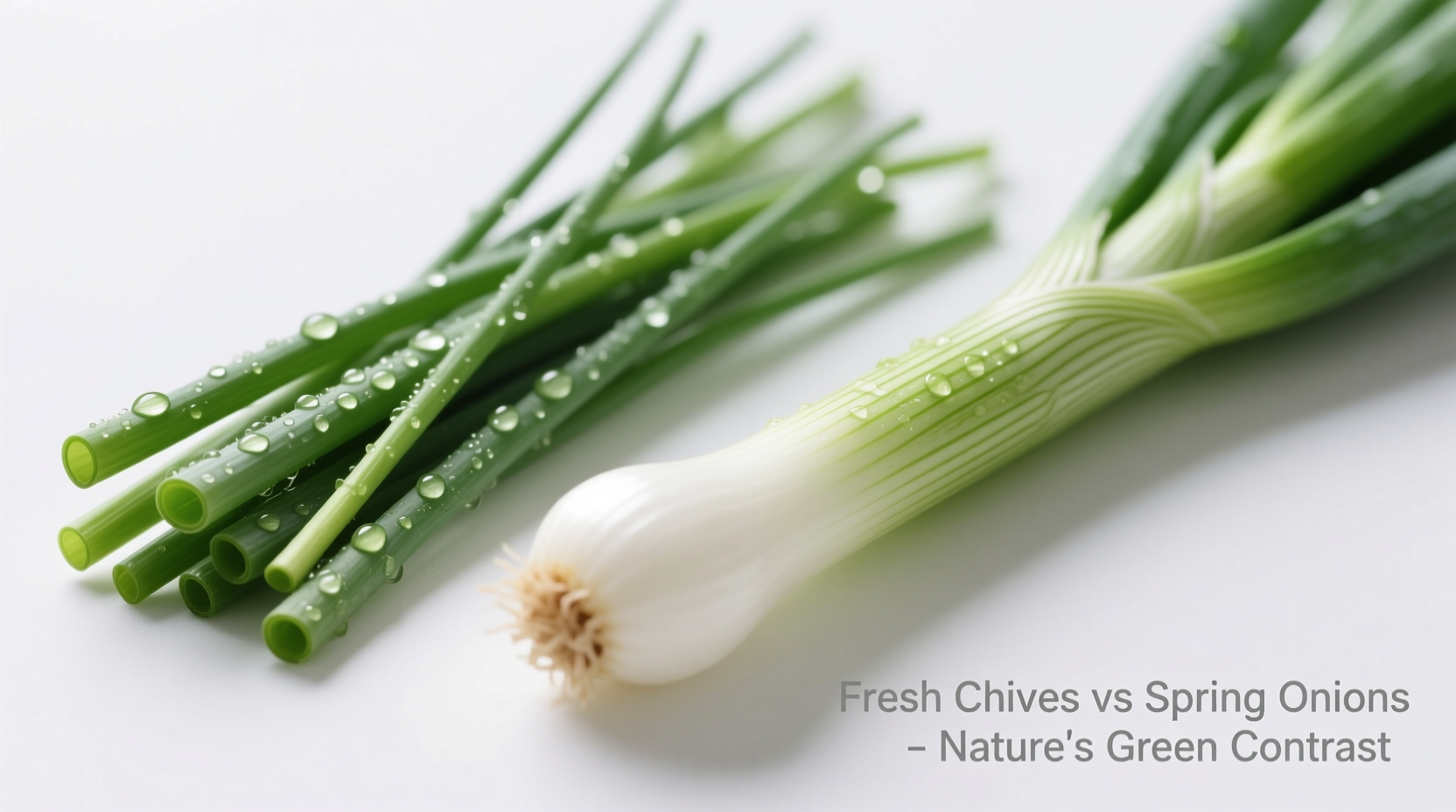Many home cooks confuse chives and spring onions, leading to disappointing dishes. This comprehensive guide clarifies their botanical differences, flavor profiles, and ideal culinary applications—helping you elevate your cooking with precise ingredient selection. Whether you're preparing a delicate sauce or a robust stir-fry, knowing when to reach for each ingredient makes all the difference.
Visual Identification: Spotting the Difference at a Glance
Before discussing usage, let's establish how to visually distinguish these commonly confused ingredients. Chives appear as uniform, thin, hollow green tubes without any bulb formation. Spring onions, however, feature a distinct white bulb at the base with green tops that may be solid or partially hollow.
| Characteristic | Chives | Spring Onions |
|---|---|---|
| Botanical Name | Allium schoenoprasum | Allium cepa var. aggregatum |
| Plant Type | Perennial herb | Immature bulb onion |
| Stem Structure | Fully hollow | Solid lower portion, hollow upper |
| Bulb Development | No bulb | Small white bulb (1-2 inches) |
| Flavor Intensity | Mild, delicate | Stronger, more pungent |

Flavor Profiles and Culinary Chemistry
Understanding the flavor chemistry helps explain why these ingredients behave differently in cooking. Chives contain lower concentrations of allyl sulfides—the compounds responsible for onion flavor—which gives them their subtle taste. Spring onions, being immature bulb onions, contain higher concentrations that intensify when cut or cooked.
According to USDA nutritional data, both ingredients offer valuable nutrients but with notable differences. Spring onions provide significantly more vitamin C (18mg per 100g) compared to chives (30mg per 100g), while chives contain higher concentrations of vitamin K and certain antioxidants.
Practical Cooking Applications by Dish Type
Professional chefs select between these ingredients based on specific culinary requirements. Here's how to make the right choice for your cooking scenario:
Delicate Dishes Requiring Subtle Flavor
For egg dishes, creamy sauces, or seafood preparations where overpowering onion flavor would dominate, chives are ideal. Their mild flavor complements without overwhelming. Add them after cooking as a garnish to preserve their delicate flavor compounds, which break down quickly with heat.
Robust Dishes Needing Onion Flavor
Spring onions work better in stir-fries, grilled dishes, or soups where you want noticeable onion presence. Their white bulb portion can be sautéed to develop sweetness, while the green tops add color and mild flavor when added later in cooking. Unlike chives, spring onions maintain their structure and flavor when exposed to heat.
Substitution Guidance: When and How to Swap
While not perfect substitutes, understanding appropriate swaps prevents recipe failures. If substituting chives for spring onions, use 1 tablespoon fresh chives for every ¼ cup chopped spring onions. For the reverse substitution, use 2-3 times more chives to achieve similar flavor impact—but be cautious as excessive chives won't replicate the textural element of spring onion bulbs.
Food science research from Cornell University's agricultural extension shows that chives lose 60% of their flavor compounds within 5 minutes of cooking, while spring onions retain flavor integrity for up to 15 minutes—making timing crucial when substituting.
Growing and Storage Best Practices
Home gardeners should know these plants have different growing requirements. Chives grow as perennial clumps from rhizomes and can be harvested continuously throughout the growing season. Spring onions are typically grown as annuals from seed or sets, harvested when bulbs are still small.
For storage, keep chives wrapped in slightly damp paper towels in an airtight container in the refrigerator (up to 10 days). Spring onions last longer—up to 2 weeks—when stored upright in a glass of water in the refrigerator, with the bulbs submerged.
Common Mistakes to Avoid
Many home cooks make these critical errors when using these ingredients:
- Overcooking chives - Always add at the very end of cooking
- Using spring onion bulbs raw in delicate dishes - Their stronger flavor can overwhelm subtle recipes
- Confusing scallions with spring onions - True spring onions have a developed bulb, while scallions don't
- Improper storage - Both lose flavor quickly when stored incorrectly
Nutritional Comparison for Health-Conscious Cooks
While both offer health benefits, their nutritional profiles differ significantly. Chives provide higher concentrations of vitamin K (213% of daily value per 100g) crucial for blood clotting and bone health. Spring onions contain more vitamin C (20% of daily value) and dietary fiber. Both contain allicin compounds with potential cardiovascular benefits, though spring onions deliver these in higher concentrations.











 浙公网安备
33010002000092号
浙公网安备
33010002000092号 浙B2-20120091-4
浙B2-20120091-4